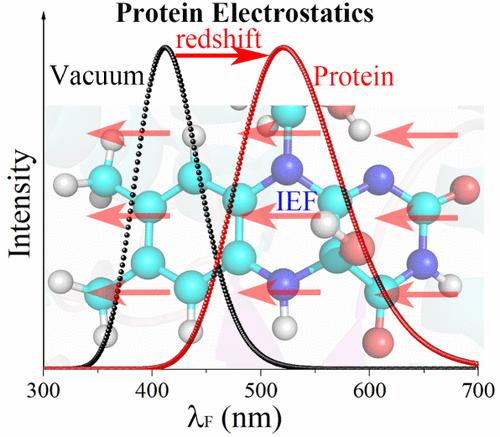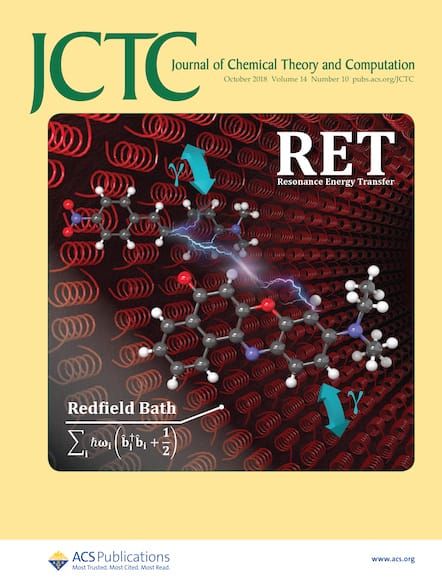荧光光谱调谐机制的理论洞察:依赖黄素的细菌荧光素酶案例研究
IF 5.7
1区 化学
Q2 CHEMISTRY, PHYSICAL
引用次数: 0
摘要
细菌的生物发光被广泛应用于生物成像、环境毒物检测和许多其他场合。了解光谱调谐机制不仅有助于解释在自然界中观察到的色彩多样性,还能为生物工程提供新的色彩变体,从而实现实际应用。本研究采用时变密度泛函理论(TD-DFT)和量子力学与分子力学(QM/MM)计算来理解细菌荧光素酶的荧光光谱调谐机制,重点关注静电效应。均匀的电介质环境和定向外电场(OEEFs)都可以调节荧光光谱。增加溶剂极性会导致荧光发射最大值λF的红移,同时密度也会大幅增加。相反,沿着异咯嗪环的长轴(X 轴)施加 OEEF 会导致 λF 发生显著的红移或蓝移(取决于 OEEF 的方向),但强度变化要小得多。极性溶剂的影响没有方向性,红移可归因于 S1 状态的偶极矩比 S0 状态的偶极矩大。然而,OEEFs 的效应与 S1 和 S0 状态之间的偶极矩差直接相关,而偶极矩差是有方向性的,是由去激发时的电荷再分布决定的。此外,细菌荧光素酶的静电效应与指向负 X 方向的内电场(IEF)的存在是一致的。最后,我们讨论了造成这种内电场的关键残基,以及通过定点突变调节光谱的策略。本文章由计算机程序翻译,如有差异,请以英文原文为准。

Theoretical Insight into the Fluorescence Spectral Tuning Mechanism: A Case Study of Flavin-Dependent Bacterial Luciferase
Bioluminescence of bacteria is widely applied in biological imaging, environmental toxicant detection, and many other situations. Understanding the spectral tuning mechanism not only helps explain the diversity of colors observed in nature but also provides principles for bioengineering new color variants for practical applications. In this study, time-dependent density functional theory (TD-DFT) and quantum mechanics and molecular mechanics (QM/MM) calculations have been employed to understand the fluorescence spectral tuning mechanism of bacterial luciferase with a focus on the electrostatic effect. The spectrum can be tuned by both a homogeneous dielectric environment and oriented external electric fields (OEEFs). Increasing the solvent polarity leads to a redshift of the fluorescence emission maximum, λF, accompanied by a substantial increase in density. In contrast, applying an OEEF along the long axis of the isoalloxazine ring (X-axis) leads to a significant red- or blue-shift in λF, depending on the direction of the OEEF, yet with much smaller changes in intensity. The effect of polar solvents is directionless, and the red-shifts can be attributed to the larger dipole moment of the S1 state compared with that of the S0 state. However, the effect of OEEFs directly correlates with the difference dipole moment between the S1 and S0 states, which is directional and is determined by the charge redistribution upon deexcitation. Moreover, the electrostatic effect of bacterial luciferase is in line with the presence of an internal electric field (IEF) pointing in the negative X direction. Finally, the key residues that contribute to this IEF and strategies for modulating the spectrum through site-directed point mutations are discussed.
求助全文
通过发布文献求助,成功后即可免费获取论文全文。
去求助
来源期刊

Journal of Chemical Theory and Computation
化学-物理:原子、分子和化学物理
CiteScore
9.90
自引率
16.40%
发文量
568
审稿时长
1 months
期刊介绍:
The Journal of Chemical Theory and Computation invites new and original contributions with the understanding that, if accepted, they will not be published elsewhere. Papers reporting new theories, methodology, and/or important applications in quantum electronic structure, molecular dynamics, and statistical mechanics are appropriate for submission to this Journal. Specific topics include advances in or applications of ab initio quantum mechanics, density functional theory, design and properties of new materials, surface science, Monte Carlo simulations, solvation models, QM/MM calculations, biomolecular structure prediction, and molecular dynamics in the broadest sense including gas-phase dynamics, ab initio dynamics, biomolecular dynamics, and protein folding. The Journal does not consider papers that are straightforward applications of known methods including DFT and molecular dynamics. The Journal favors submissions that include advances in theory or methodology with applications to compelling problems.
 求助内容:
求助内容: 应助结果提醒方式:
应助结果提醒方式:


